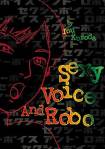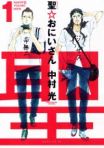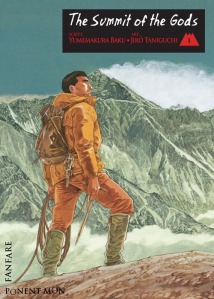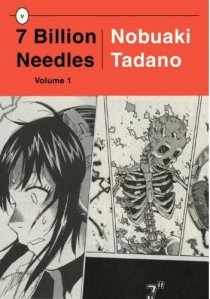Deep breaths, everyone.
“S” is for…
Shogakukan and Shueisha, publishers of a great deal of seinen (among other kinds of manga and all kinds of books in general) who also co-own Viz Media.
Signature, Viz Media’s high-end imprint, which is where a great deal of the publisher’s seinen output can be found. You can read a lot of it at the SigIKKI site, which allows you to read titles from Shogakukan’s IKKI magazine. (When will we get a site that focuses on one of Shueisha’s seinen magazines? Does Shueisha have an IKKI equivalent?)
Among those SigIKKI titles is Saturn Apartments, written and illustrated by Hisae Iwaoka. It’s about the people who wash the windows of an orbital residential complex, and it’s one of the best new series of the year.
Kumiko Suekane contributes another SigIKKI title, Afterschool Charisma, which is kind of dumb but fun. It’s about clones of famous historical figures who all go to the same boarding school.
 Sexy Voice and Robo (Viz), written and illustrated by Iou Kuroda, and one of my favorite manga. It was the topic of the very first Manga Moveable Feast. It originally ran in IKKI.
Sexy Voice and Robo (Viz), written and illustrated by Iou Kuroda, and one of my favorite manga. It was the topic of the very first Manga Moveable Feast. It originally ran in IKKI.
 Short Cuts (Viz), written and illustrated by Usumaru Furuya. It’s Furuya’s take on the cultural obsession with schoolgirls. It originally ran in Shogakukan’s Weekly Young Sunday.
Short Cuts (Viz), written and illustrated by Usumaru Furuya. It’s Furuya’s take on the cultural obsession with schoolgirls. It originally ran in Shogakukan’s Weekly Young Sunday.
 Short Program (Viz), written and illustrated by Mitsuru Adachi, isn’t all seinen, but a lot of it is, and Adachi’s Cross Game is so brilliant that I had to mention it, even though Viz only published two of the title’s four volumes, and that was a decade ago. Here’s a breakdown of the stories and their sources.
Short Program (Viz), written and illustrated by Mitsuru Adachi, isn’t all seinen, but a lot of it is, and Adachi’s Cross Game is so brilliant that I had to mention it, even though Viz only published two of the title’s four volumes, and that was a decade ago. Here’s a breakdown of the stories and their sources.
 solanin (Viz), written and illustrated by Inio Asano, which offers a memorable take on aimless twenty-somethings. It originally ran in Shogakukan’s Weekly Young Sunday.
solanin (Viz), written and illustrated by Inio Asano, which offers a memorable take on aimless twenty-somethings. It originally ran in Shogakukan’s Weekly Young Sunday.
 I’ll readily confess that I don’t know anything about Saikano (Viz), written and illustrated by Shin Takahashi, except that it was originally serialized in Shogakukan’s Big Comic Spirits and that it involves characters who have “been engineered by the Japanese Self Defense Force to transform into the Ultimate Weapon!” Please feel free to speak to its many virtues, if you are qualified and inclined to do so.
I’ll readily confess that I don’t know anything about Saikano (Viz), written and illustrated by Shin Takahashi, except that it was originally serialized in Shogakukan’s Big Comic Spirits and that it involves characters who have “been engineered by the Japanese Self Defense Force to transform into the Ultimate Weapon!” Please feel free to speak to its many virtues, if you are qualified and inclined to do so.
Finishing up on the Viz front, how tragic is it that Secret Comics Japan is out of print? It’s a collection of edgy, alternative manga that is a bookshelf highlight for me.
Drawn & Quarterly published Imiri Sakabashira’s fever dream of a graphic novel, The Box Man, which was originally published by SeirinKogeisha, who also published seminal manga magazines Garo and AX. Sakabashira’s work was also included in AX, the collection from Top Shelf.
Drawn & Quarterly also plans to publish Oji Suzuki’s A Single Match next year. It originally ran in Garo.
Summit of the Gods (Fanfare/Ponent Mon), a great tale of mountain climbers written and illustrated by Jiro Taniguchi. It originally ran in Shueisha’s Business Jump.
Taniguchi created the one-volume Samurai Legend (Central Park Media) with Kan Furuyama. It originally ran in Akita Shoten’s Young Champion.
For seriously seinen-y manga, you could turn to Dark Horse for Samurai Executioner, written by Kazuo Koike and illustrated by Goseki Koijima. It was originally published by Kodansha.
 Or you could turn to Dark Horse for half of Satsuma Gishiden, written and illustrated by Hiroshi Hirata. The six-volume series was originally published by Nihon Bungeisha; Dark Horse put the title on hiatus after publishing three volumes. I very much enjoyed the first volume, which I read rather belatedly, and plan to pick up the other two while keeping my fingers crossed that the hiatus will prove to be temporary. Long, but temporary.
Or you could turn to Dark Horse for half of Satsuma Gishiden, written and illustrated by Hiroshi Hirata. The six-volume series was originally published by Nihon Bungeisha; Dark Horse put the title on hiatus after publishing three volumes. I very much enjoyed the first volume, which I read rather belatedly, and plan to pick up the other two while keeping my fingers crossed that the hiatus will prove to be temporary. Long, but temporary.
Yen Press has a few four-panel titles that start with “S.”
There’s Satoko Kiyuduki’s excellent Shoulder-a-Coffin Kuro, which originally ran in Houbunsha’s Manga Time Kiara. Sunshine Sketch, written and illustrated by Ume Aoki, originally ran in Houbunsha’s Manga Time Kiara Carat. And there’s Negi Banno’s S.S. ASTRO: Asashio Sogo Teachers’ ROom, which was also from Manga Time Kiara Carat.
Yen also offers Kazuto Okada’s Sundome, which was memorably discussed in this Manga Out Loud podcast. Sundome was visited upon the world by Akita Shoten’s Young Champion.
I should theoretically do a number entry for this alphabet, but I think I can avoid that without too many omissions. To start, there’s 7 Billion Needles (Vertical), an excellent sci-fi title from Nobuaki Tadano, inspired by Hal Clement’s classic novel, Needle. It originally ran in Media Factory’s Comic Flapper.
Two examples of seinen magazines include…
Shogakukan’s Sunday GX…
And Shueisha’s Super Jump.
 Because this letter has felt virtually endless, I’ll just go with a small handful of promising-sounding unlicensed titles.
Because this letter has felt virtually endless, I’ll just go with a small handful of promising-sounding unlicensed titles.
Everyone wants someone to publish Hiraku Nakamura’s Saint Young Men, serialized in Kodansha’s Morning. It has just been picked up for publication in French by Kurokawa.
A Spirit of the Sun, written and illustrated by Kaiji Kawaguchi, originally serialized in Shogakukan’s Big Comic.
What starts with “S” in your seinen alphabet?
Updates: Sound the klaxons! I have made a glaring omission that must be corrected. Fuyumi Soryo may be best known to some for her outstanding shôjo works like Mars (Tokyopop), but she’s also equally admired by fans of seinen titles like ES: Eternal Sabbath (Del Rey) and the yet-to-be-licensed Cesare, a meticulously researched look at the life of a notorious Italian nobleman.
Glaring omission the second! The Strange Tale of Panorama Island, Suehiro Mauro’s adaptation of a work by Edogawa Rampo, is due from Last Gasp in 2011. It was originally serialized in Enterbrain’s Comic Beam.
And glaring omission the third! Felipe Smith is living the dream, having started his career as a manga-ka with MBQ at Tokyopop, moving on to the three-volume Peepo Choo, serialized in Kodansha’s Morning Two and published in English by Vertical.















